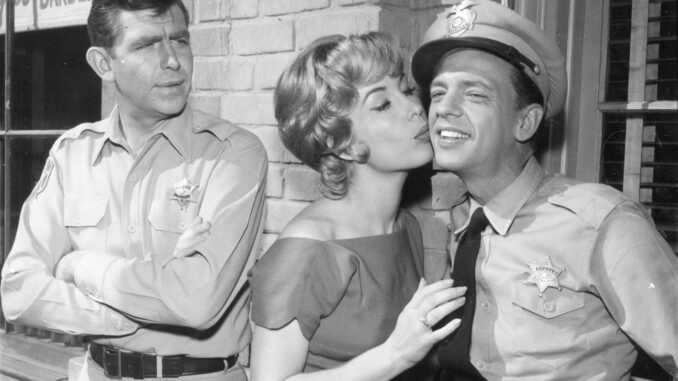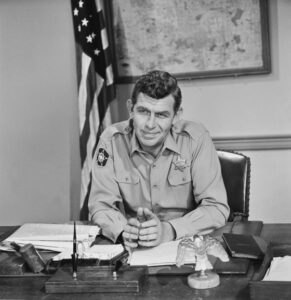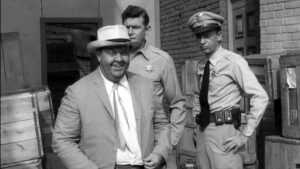
Introduction: The Unexpected Drama Behind ‘The Andy Griffith Show’
When you think of The Andy Griffith Show, you probably imagine the warm, small-town charm of Mayberry, the hilarious antics of Sheriff Andy Taylor, and the unforgettable cast of characters. But behind the scenes of this beloved show, there was a key decision that could have changed everything: Andy Griffith’s choice to fight against having a live studio audience.
You might be surprised to learn that this decision wasn’t just a small production choice—it was a major part of the show’s success. Let’s dive into why Andy Griffith was so adamant about keeping the audience at bay, and how this choice shaped the feel of the show and its iconic legacy.
Why Did Andy Griffith Reject the Idea of a Live Audience?
The decision to keep The Andy Griffith Show free of a live audience might seem unusual, especially considering that many TV sitcoms of the era relied on the energy and laughter from a studio crowd. However, Andy Griffith’s refusal to follow this traditional route had a profound effect on the show’s tone and the way it was received by audiences.
Andy Griffith’s Vision for the Show
Andy Griffith had a clear vision for his show from the start. He wanted The Andy Griffith Show to feel like a natural, down-to-earth portrayal of life in a small Southern town. With no distractions from artificial laughs, Griffith hoped the focus would remain on the real emotions and relationships between the characters.

The Fear of “Schtick” Comedy
Griffith was particularly worried about the potential for The Andy Griffith Show to turn into a typical sitcom filled with forced jokes, relying on an external cue (laughter from the audience) to tell the actors when something was funny. He believed that a live audience would encourage the cast to perform in a more exaggerated manner, turning the show into something it was never meant to be.
Think of it like a stand-up comedian trying to win over a crowd—it might seem like more energy is needed to get a reaction. But when the audience isn’t there, the focus shifts back to genuine interaction.
Why the Absence of a Live Audience Made the Show Timeless
Without the pressure of needing to “perform” for an audience, the actors on The Andy Griffith Show were free to keep their portrayals grounded and authentic. This created a sense of intimacy, drawing viewers into the heart of Mayberry and making them feel like part of the community. In a way, it was a little like eavesdropping on a conversation between friends.
The Role of the Live Audience in 1960s TV
To understand why Andy Griffith’s decision was so bold, it’s essential to look at the broader context of television during the 1960s. At the time, most sitcoms had live audiences, with shows like I Love Lucy and The Dick Van Dyke Show setting the stage for a formula that was hard to break.
Live Audiences: The Standard of the Era
A live studio audience was the norm for sitcoms in the 1960s. It wasn’t just about the added excitement—audiences served as a tool for directors and actors to gauge reactions and adjust performances in real-time. For many producers and creators, the laughter of a live audience was an essential part of the sitcom formula. But Andy Griffith wasn’t interested in sticking to the status quo.
The Challenge of Breaking Tradition
Imagine being an actor on a classic 1960s sitcom and not having the comfort of hearing a live laugh track. The absence of this immediate feedback was a bold move, one that left Griffith’s show walking on a tightrope. Still, Griffith’s steadfast commitment to authenticity won out.
How It Changed the Industry
The success of The Andy Griffith Show helped to prove that a sitcom didn’t need a live audience to be effective. This decision set a precedent for other shows to follow, such as The Mary Tyler Moore Show and MASH*, which would later thrive without the use of a live crowd.
The Creative Impact on the Cast and Crew
The choice to avoid a live audience didn’t just impact the show’s tone—it changed how the cast and crew interacted with the material.

A More Relaxed Atmosphere on Set
With no audience to impress, the cast was able to perform without the pressure of delivering punchlines that were specifically timed for audience laughs. This created a more relaxed environment for the actors, allowing them to focus on their performances and build stronger chemistry. It wasn’t about “getting a laugh” in every moment, but about telling a genuine story.
Developing Real Emotional Moments
Some of the most touching and memorable moments of The Andy Griffith Show wouldn’t have been possible in a live-audience format. The absence of forced humor made room for heartfelt moments between characters, like the tender relationship between Andy and Opie.
A Show Built on Realism, Not Gimmicks
For Griffith, The Andy Griffith Show was about showing life as it truly was—not about delivering punchlines on cue. By opting out of a live audience, Griffith ensured that the show stayed true to its roots as a heartfelt, realistic portrayal of small-town life.
Behind the Scenes: Griffith’s Relationship with the Show’s Creators
While Andy Griffith took a strong stance on keeping the show without a live audience, it’s important to remember that this wasn’t a decision he made in isolation.
The Impact on the Show’s Writers and Directors
Griffith’s choice affected the entire creative team behind The Andy Griffith Show. Writers had to be extra careful with their dialogue, ensuring that it wasn’t reliant on cues for laughter. Directors also had to make sure that the pacing and timing worked for the show’s more natural, slower pace.
A Collaborative Effort in Breaking the Mold
This wasn’t just Griffith’s victory—it was a team effort. Writers like Sheldon Leonard and Danny Thomas were on board with Griffith’s vision, and together they crafted a show that defied the conventions of its time.
Lasting Legacy: The Influence on TV Sitcoms Today
The decision to avoid a live studio audience didn’t just affect The Andy Griffith Show. It had a ripple effect across television, influencing how sitcoms would be produced for years to come.
The Rise of Single-Camera Sitcoms
Without the need for a live audience, The Andy Griffith Show helped pave the way for single-camera sitcoms, which have become a hallmark of modern television. Shows like The Office and Parks and Recreation owe part of their success to the groundwork laid by Griffith’s decision.
A Shift Toward Authenticity in Television
Griffith’s decision to keep the show free from a live audience was part of a larger trend in TV that prioritized authenticity over gimmicks. As viewers grew tired of artificial laughter, more shows began to embrace a quieter, more natural approach to comedy.
Conclusion: Why Andy Griffith’s Bold Decision Still Matters Today
The decision to reject a live studio audience on The Andy Griffith Show was more than just a personal preference—it was a bold statement about the kind of show Griffith wanted to create. By focusing on authenticity and realistic portrayals of life in Mayberry, Griffith crafted a sitcom that would resonate with audiences for decades. Today, his decision still influences how sitcoms are made, proving that sometimes, breaking tradition can lead to lasting success.
5 FAQs About Andy Griffith and the Live Audience Decision
1. Why did Andy Griffith not want a live audience on his show? Andy Griffith wanted The Andy Griffith Show to focus on authentic, natural performances without the distraction of a live audience’s laughter. He feared it would detract from the show’s realism.
2. Did any other shows follow Andy Griffith’s decision to avoid a live audience? Yes, other shows like The Mary Tyler Moore Show and MASH* followed suit by avoiding live audiences, paving the way for single-camera sitcoms.
3. How did the absence of a live audience affect the actors’ performances? Without the pressure of a live audience, actors were able to focus on delivering more genuine and relaxed performances, enhancing the authenticity of the show.
4. Did the absence of a live audience hurt the show’s popularity? No, in fact, The Andy Griffith Show became incredibly popular and is still considered one of the best sitcoms of all time, proving that a live audience wasn’t necessary for success.
5. What impact did Andy Griffith’s decision have on modern TV shows? Griffith’s decision to avoid a live audience helped inspire a shift in television, leading to the rise of single-camera sitcoms and a more authentic approach to comedy.
